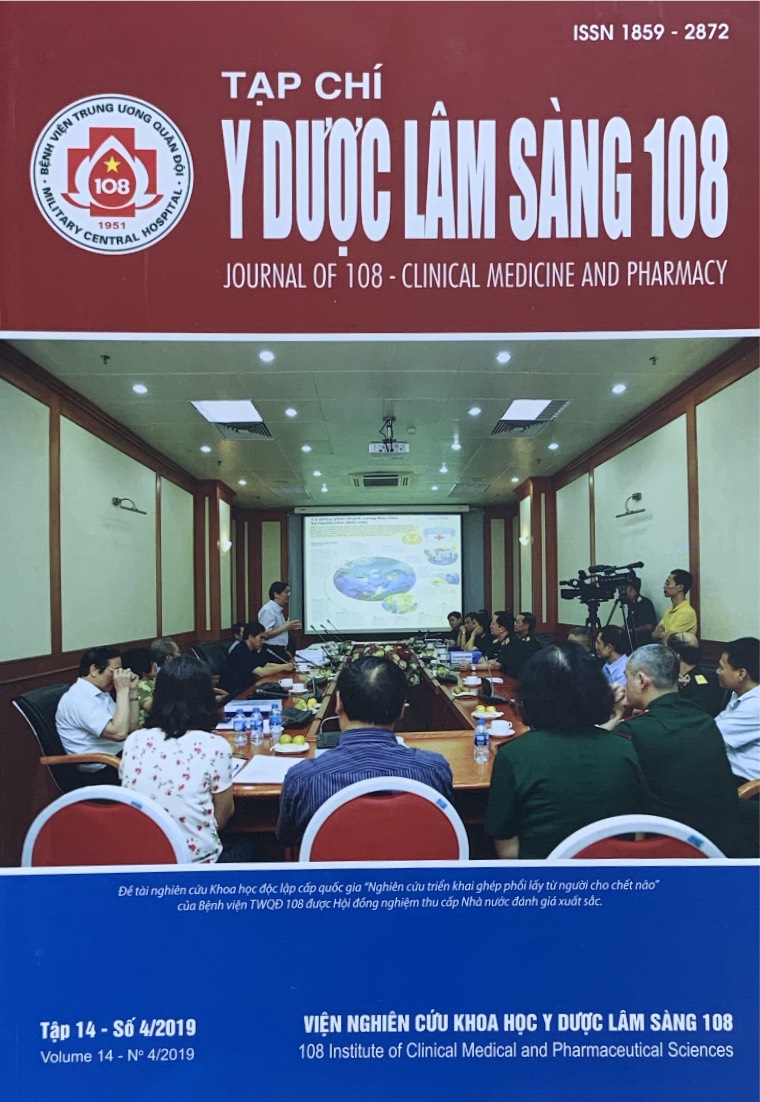The relationships between SUVmax and morphologic features of bone metastatic lesions on 99mTc-MDP SPECT/CT in known cancer patients
Main Article Content
Keywords
Abstract
Objective: The aim of our study was to evaluate the relationships between SUVmax and morphologic features of bone metastasis on 99mTc-MDP SPECT/CT in known cancer patients. Subject and method: This prospective study enrolled 90 cancer patients (32 women and 58 men patients with aged average of 61.6 ± 10.4) underwent 99mTc-MDP SPECT/CT scans from February 2018 to February 2019 at Nuclear Medicine Department, 108 Military Central Hospital. Bone metastatic lesions were classified based on morphologic features on CT. The standardized uptake values (SUVmax) were measured at each morphologic features of bone metastasis and determining the relationships between SUVmax and those lesions in different cancer diseases. Result: The total of 264 lesions were found in 90 patients. Of which, 29% were osteolytic, 25% were osteoblastic, 23% were mixed and 23% were unclassified lesions on CT. SUVmax values at osteolytic lesions were significantly lower than other types of lesions (p<0.05). SUVmax values of bone lesions in thyroid cancer, liver cancer patients were lower compared to those in prostate cancer and lung cancer patients. This difference was statistically significant (p<0.05). Conclusion: The morphologic features of bone metastatic lesions on CT were found to be in correlation to metabolic bone changes on 99mTc-MDP SPECT/CT imaging.
Article Details
References
2. Nguyễn Thị Nhung, Lê Ngọc Hà và cộng sự (2018) Giá trị của SPECT/CT trong đánh giá tổn thương xương do di căn. Tạp chí Y Dược Lâm sàng 108, tập 13, số đặc biệt, tr. 154-160.
8. Kawaguchi M, Tateishi U, Shizukuishi K et al (2010) 18F-fluoride uptake in bone metastasis: Morphologic and metabolic analysis on integrated PET/CT. Annals of Nuclear Medicine 24(4): 241-247.
9. Katagiri H, Takahashi M, Wakai K et al (2005) Prognostic factors and a scoring system for patients with skeletal metastasis. The Journal of Bone and Joint Surgery British 87-B(5): 698-703.
5. Kuji I, Yamane T, Seto A et al (2017) Skeletal standardized uptake values obtained by quantitative SPECT/CT as an osteoblastic biomarker for the discrimination of active bone metastasis in prostate cancer. Eur J Hybrid Imaging 1(1): 2-17.
3. Macedo F, Ladeira K et al (2017) Bone metastases: an overview. Oncol Rev 11(1): 43-49.
7. Palmedo H, Marx C, Ebert A et al (2014) Whole-body SPECT/CT for bone scintigraphy: Diagnostic value and effect on patient management in oncological patients. European Journal of Nuclear Medicine and Molecular Imaging 41(1): 59-67.
4. Sharma P, Kumar R, Singh H et al (2012) Indeterminate lesions on planar bone scintigraphy in lung cancer patients: SPECT, CT or SPECT-CT?. Skeletal Radiology 41(7): 843–850.
6. Wang R, Duan X, Shen C et al (2018) A retrospective study of SPECT/CT scans using SUV measurement of the normal pelvis with Tc-99m methylene diphosphonate. Journal of X-Ray Science and Technology 26(6): 895-908.
10. Ziessman HA, O’Malley JP, and Thrall JH (2014) Nuclear medicine: The requisites. Mosby Elsevier, Philadelphia.
 ISSN: 1859 - 2872
ISSN: 1859 - 2872
